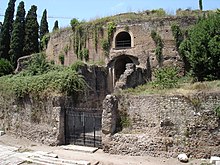Augustus Mausoleum
The Augustus mausoleum ( Italian: Mausoleo di Augusto ) on the Martius campus in Rome (today the Campo Marzio district ) was built in 29 BC. Tomb built for himself by Emperor Augustus in BC , in which some of his successors, other members of the Julio-Claudian family and other important Roman personalities were buried later .
description
The mausoleum consisted of two mighty, cylindrical blocks, one above the other, which were clad with Roman travertine and marble. The two parts of the building, about 87 meters wide and almost 40 meters high, were separated by a sloping earth wall that was planted with trees. The lower part of the structure served as the actual grave, while the upper, smaller part served as a burial temple. This structure with superposed levels comes from the Hellenistic tomb architecture. Five concentric rings of walls were built around the hill; on the top was a metal statue of the emperor. The entrance to the tomb in the south was flanked by bronze plaques containing the emperor's report, the Res gestae divi Augusti , and two obelisks stood next to it . The statue of the emperor was lost as well as the bronze plaques (there are enough stone copies of the Res Gestae, however, as the son of Augustus was instructed by the Senate to ensure that this report was widespread in the empire - one is in the Monumentum, for example Ancyranum in Ankara , Turkey ). The obelisks, the Obelisco del Quirinale and the Obelisco Esquilino , stand today on the Piazza del Quirinale , as part of the Dioscuri fountain in front of the Palazzo del Quirinale , the seat of the Italian President, and on the Piazza Esquilino in front of the Basilica Santa Maria Maggiore . Of the mausoleum itself, only the lower parts of the core and the remains of the wall rings have been preserved.
In 1926 excavations began on the Augustus mausoleum. In connection with the lavishly celebrated two thousandth birthday of the first Roman emperor, who had just returned to the center of attention under Mussolini , the monument was uncovered from 1936 to 1938 and, according to plans by the architect Vittorio Ballio Morpurgo, a rectangular square in the fascist- rationalist space in 1937/40 Style. Mussolini is said to have chosen it himself as his tomb. Currently, the enclosure of the entire mausoleum by a museum building similar to that of the Ara Pacis located next door is under discussion.
The mausoleum is located in Piazza Augusto Imperatore, west of the upper part of Via del Corso . The tomb cannot currently be visited, but the city of Rome announced in May 2017 that the mausoleum should be restored by 2019 with the help of a donation from the Italian telecom operator TIM of 6 million euros. After completion of the construction work, the building should be accessible to visitors again. (As of August 2017)
List of known buried personalities
- Marcellus († 23 BC)
- Marcus Vipsanius Agrippa († 12 BC)
- Octavia Minor († 11 BC)
- Drusus († 9 BC)
- Publius Quinctilius Varus († 9 AD)
- Lucius Caesar († 2 AD)
- Gaius Caesar († 4 AD)
- Augustus († 14 AD)
- Germanicus († 19 AD)
- Drusus the Younger († 23 AD)
- Livia Drusilla († 29 AD)
- Nero Caesar († 30 AD, later buried in 37 AD)
- Agrippina the Elder († 33 AD)
- Tiberius († 37 AD)
- Caligula († 41 AD)
- Claudius († 54 AD)
- Britannicus († 55 AD)
- Poppaea Sabina († 65 AD)
- Vespasianus (? Uncertain; † 79 AD)
- Nerva († 98 AD)
- Julia Domna († 217 AD)
Individual evidence
- ^ Marco Bussagli: Rome, Art & Architecture . Könemann, Cologne 1999, p. 72-74 .
- ^ Augustus mausoleum in Rome is being restored. May 2, 2017. Retrieved August 27, 2017 .
- ^ Suetonius, Cal . 15, 1; CIL 6, 887
- ^ Later transferred to Hadrian's mausoleum at the instigation of Julia Maesa ; see Cassius Dio 79 (78), 24.3.
literature
- Henner von Hesberg , Silvio Panciera : The mausoleum of Augustus. The building and its inscriptions (= Bavarian Academy of Sciences, Philosophical-Historical Class. Treatises. NF 108). Publishing house of the Bavarian Academy of Sciences, Munich 1994, ISBN 3-7696-0103-3 .
- Paul Zanker : Augustus and the power of images. CH Beck, Munich 1987, ISBN 3-406-32067-8 .
Web links
- Official homepage of the Mausoleo di Augusto (Italian)
- Augustus Mausoleum - text and image
- Augustus mausoleum at Livius.org - text and picture
Coordinates: 41 ° 54 ′ 22 " N , 12 ° 28 ′ 35" E


